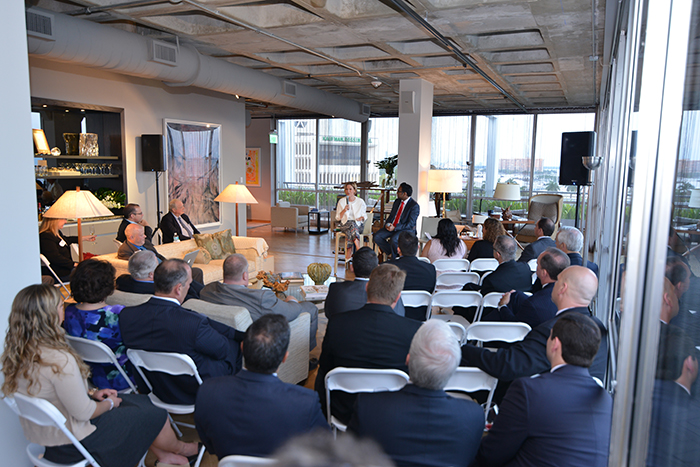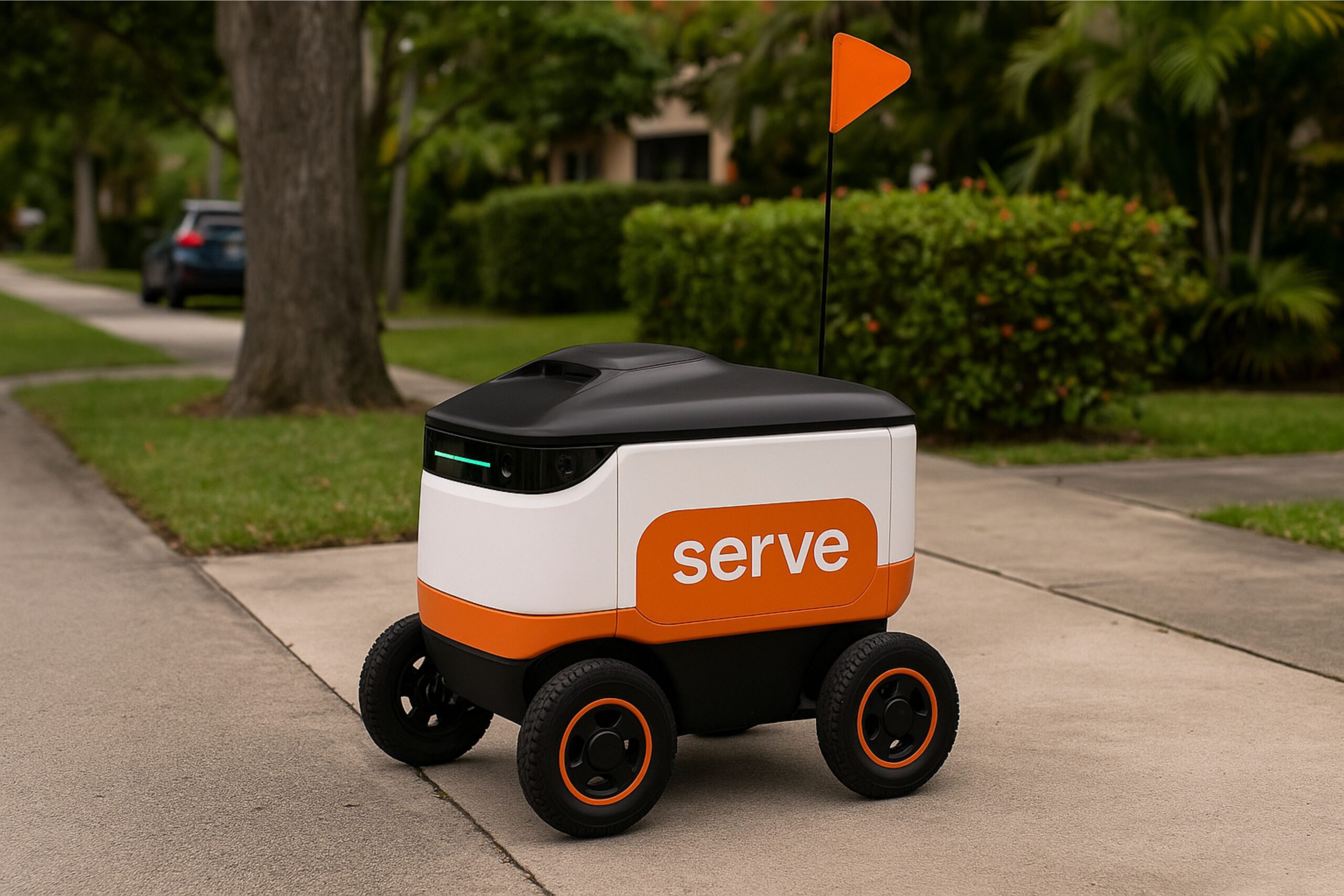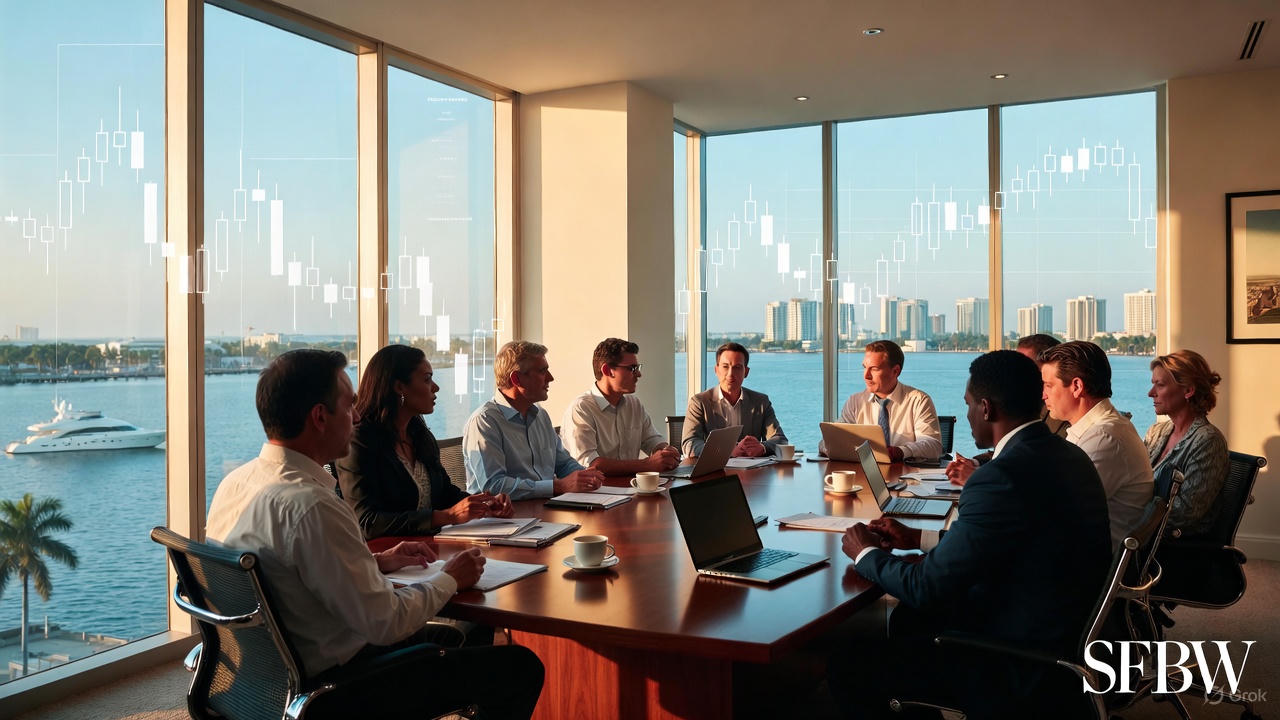SFBW presented a twist on its CEO Connect series by having one top Miami-area leader interview another one.
Asking the questions was Saif Y. Ishoof, Esq., Vice President & Executive Director of City Year Miami.
City Year enlists volunteers to provide one-on-one help so students stay on track and graduate.
Answering the questions was Tere Blanca, the Founder, President and CEO of Blanca Commercial Real Estate, a leading Miami-based commercial property real estate advisory services and brokerage firm.
Blanca has more than 25 years of experience in the South Florida real estate sector and previously served as Senior Managing Director for Cushman & Wakefield of Florida and Senior Vice President at Codina Realty Services. Blanca is a past chairwoman of the Beacon Council, a board member at BankUnited and a trustee of the Greater Miami Chamber of Commerce.
SFBW asked Ishoof to do the interview since he knows Blanca well in her role as chairwoman of City Year.
The CEO Connect was held in the sales center for Park Grove Residences, a Coconut Grove project being developed by Terra Group and Related Group.
What follows is an edited transcript.
Ishoof: I thought I would start off Tere by asking you to share a little bit, sort of a 90 second overview, of your personal background and your biography.
Blanca: I was born in Cuba and I was not raised in Miami like many of my friends. My parents sent us off to Puerto Rico with my maternal grandparents in 1961, and about a year and a half later, my parents came to Puerto Rico and that was because my grandfather was the only one in the family who had had any international connections. He was a banker in Cuba and knew people in Puerto Rico that were gracious to him and gave him an opportunity to get started again banking in Puerto Rico.
My father was an attorney. My mom was an architect and so there we landed in a little town of maybe 80,000 people at the time. I went to Sacred Heart School and went home for lunch everyday. In 1975, my father moved us to Caracas. That’s where I finished my high school years, and then later in 1979 we moved to Miami.
I attended UM for undergrad and then to grad school and I’ve been here pretty much since – except I had a short stay in San Diego for about three years. Everybody thought I was crazy coming back to Miami, but little did they know what I thought was going to happen here. You know, it felt like such a great town, a place to build your life and I’m happy that I chose to come back.
Ishoof: What was your first job after college?
Blanca: I was 17 when I started at the university and so I thought I wanted to follow my grandfather’s footsteps and I thought I would be in banking. So from the age of 17 I started working in banking, filing checks and working in the customer service area. After I graduated from the business school at UM I ended up working in banking for two years.
They sent me to work in the operations side of the bank and I hated it, with a passion. So I said, I don’t think I want to do this the rest of my life so I went back to school to get my masters.
Ishoof: How did you transition from banking to real estate, which is what you’re known for in this community?
Blanca: I always say to young people that they just never know when things are going to change. And they’re going to find their passion and to not be afraid to open the door. For me, I was in San Diego at the time, I was working there with a technology company in sales. And I loved the sales aspect of it but I wanted to go back to a sales job that had something to do with what I studied.
Then, one of my friends said, “Hey have you ever tried commercial real estate?” California was the seat of real estate with Cushman and Wakefield and it’s where CBRE started. It was the heart of that real estate service industry and I said, “OK, let me find out about this.”
Ishoof: When you landed back here in South Florida, who were some of those leaders that you looked to and you had an opportunity to have as mentors?
Blanca: I was just really absolutely so lucky to have such great role models and mentors around me. From an early time when I started my career, of course with my grandfather, my mom, my dad, you know, making it happen after leaving Cuba with nothing. And then later in life, professionally, Jack Lowell, Armando Codina, Jeb Bush and you know, the list goes on and on.
Ishoof: So you arrived back here into a lot of the sort of chaos of the early “80’s in real estate market and you’ve seen a number of the different waves that occurred. What is the common theme that you’ve seen sort of evolve in the several different real estate cycles that we’ve seen?
Blanca: It would always bounce back a lot faster than anyone expects. Miami surprises everyone. Everyone thought that we were going to be stuck for 10 years and look what’s happened.
I think the biggest difference and what feels very different today of course is the maturity that we’re starting to experience in Miami from the investor profile, from the quality of the developers that are here, the institutional orders that are here, the quality of life culturally as well as in terms of opportunity for attracting talent.
And of course, the connectivity that we offer through MIA, with direct flights internationally everywhere. So that infrastructure that our community has put in place from the airport, port, the Metrorail and Metromover and now All Aboard Florida’s trains, all of these things have been happening over the years and have allowed us to create an environment that is very appealing to people from all over the world and from over the U.S.
Someone said to me yesterday at lunch said, “New York doesn’t feel human any more.” And this is someone that lives in New York that’s moving down here and I thought it was a really strong statement. And so what Miami has is a warmth, a diversity, a maturity that is happening in so many respects that now it feels very different than the past cycles.
Will everything that gets proposed be built? Probably not. But there are a lot of solid, deep pockets investors in Miami that won’t be in trouble. They’ll know the next up-cycle will be around.
Ishoof: You touched on something that I think is particularly exciting which is the global potential of Miami, global beyond the Americas.
Blanca: The Miami brand is certainly global and prestigious. Traditionally we’ve seen lots of U.S. capital in a position for a piece of Miami, but we have Chinese investment on Miami Avenue and 15th. They’re getting an investment at the old Miami Herald headquarters. We have European money, Spanish money, German money coming in all the time.
Yesterday, I had a call from someone with one of the international banks in Switzerland that represents an investment group from Europe. They’re so frustrated because they have been bidding on various properties that have been sold in the last three months or six months and they’ve not been able to win on any one of these major acquisitions of over $100 million dollars. So, they’re calling and say, “Are we doing something wrong? Can you help us position for the right acquisition and how do we win the next time?”
These are investors who can invest anywhere in the world, but they’re choosing Miami to be here.
I get calls now from some brokers on the weekend telling me, “Oh I have a group of Chinese investors that are here for the weekend, Tere. Do you have anything that you could show us? We go back on Monday and you know, they really just want to be here and buy something.”
Well, everyone from all over the world has now recognized Miami as a place where if they’re going to have a resident status or citizenship eventually they want a place, a foothold in America. This is the place to do it.
Ishoof: You touched upon community and I think there’s a recurring theme with a lot of the leaders that we see in South Florida and you embody that. Why have you made it a professional and life choice to be so engaged in the community?
Blanca: I’ve been inspired by people like you. You don’t have to do what you do, so you follow your heart to do that. And I had so many mentors that always felt that it was the right thing to do.
As a young person in my home, it was always the right thing to do. This is not about recognition. I say it’s a little selfish because it makes me feel good and I also feel that it’s our responsibility to engage so that we can make this place a better place for everyone. Not just for a few.
Ishoof: So what was it that brought you to focus your energy in on K-12?
Blanca: So it was in 2009 I believe that I was passing the gavel to my dear friend Alex Villoch to chair the Beacon Council board and it’s been two years really of practicing as chair because the previous chairman, my best friend Pete Pizarro, had been traveling a lot.
So, I walked out of the auditorium and here is this young man standing by and he says, “Ms. Blanca, you don’t know who I am and you probably never heard about City Year. I know exactly what your next leadership role will be in this community.” I said you know, “I like you already because you definitely have guts. Give me six months and call me then. I need a little break.”
And six months exactly, Saif was calling me to share with me about the absolutely amazing work that City Year on a national level and in Miami is doing. I had an opportunity to learn about it, go to the first school visit, meet our core members and meet with the students. That was it. I had no organization at the time that I felt would align so well with my passion for education.
The Cuban family says they can take away everything but your education, no one can take it away from you. So I grew up with parents that told me that every single day and to me it’s the equalizer. Education is it what allows us to break the cycle of poverty. It’s what empowers people and we like to say in City Year that no student should be deprived, because of the zip code they live in. It doesn’t matter where you live. You ought to be honored with the power of a great education.
And so I fell in love with the work that we do with Saif and the team that he’s built. I’m fully committed to making sure that we continue to grow our work in Miami so that we can be present in 45 schools.
Ishoof: There’s a climate around education that we see in South Florida and those of us in the social enterprise sector, we feel it. We see the momentum with great organizations like Teach For America, the College Summit, the work that the United Way is doing around early learning. The work that David Lawrence [president of The Early Childhood Initiative Foundation and chair of The Children’s Movement of Florida] is doing. What is it about that sort of formula of leadership we’re seeing today at play?
Blanca: It’s really great because I feel like the stars are aligned. We are in a moment in time in Miami with the engagement of all these organizations and with the leadership that we have in place with Miami-Dade School Superintendent Alberto Carvalho and Dr. Pablo Ortiz and what you do and what higher ed does and the conversation around it and the engagement around it. Hey, we can move a mountain here.
And so we shouldn’t take our eye off the ball at this moment. We have the wealthiest and the poorest zip codes in the country. That’s a sad statement about Miami that a lot of people don’t talk about.
Ishoof: What are some of the other meta-trends that you see that are on the rise over the next 20, 25 years for South Florida?
Blanca: So I think when you drive I-95 there’s sort of a boundary or sign that says you’ve left Miami-Dade County, and you have left Broward County, and you’ve entered Palm Beach. So it feels like the region is somewhat disconnected. Right? One of the things I would love to see happen is this MSA [metropolitan statistical area] acting more like an MSA and things are coming together for the betterment of the community.
I also see a vision of dense urban nodes where people live and work and play. Hopefully, we will address transportation so that we can move about in an efficient way for this community to be very connected. From a real estate standpoint, I don’t think we’ve seen the best of it yet. We’re about to take off.
Audience question: You brought up the issue that we have the wealthiest zip code in the country, and also the poorest zip code. How do you think we correct that?
Blanca: I’m going to pass that question to my dear friend and colleague, Saif, because we have talked about this in a greater perspective.
Ishoof: We have to challenge the status quo of philanthropy in this community, and I know that it sounds very glib to say, but I think that we all have to make our friends and colleagues and business associates a little bit uncomfortable about the elements of need in our community, you know. People arrive in South Florida and they see one iteration of the community in which we live in. Right?
They can come in here for 36 hours and not really have a deeper sense of the fact that 35 miles south of here there are kids that get on the bus every single day and leave a migrant foreign labor camp that looks like a township in pre-apartheid South Africa.
We can’t settle on a status quo that says that our community is comprised of folks on two trains headed in the opposite directions.
Audience: Over the last few years, what has seemed to be the pros and cons of attracting companies here and how has that changed?
Blanca: When I was in the Beacon Council acting as a chair, we were working on one specific project where the CEO’s biggest concern was K-12 education, accessible K-12 educational quality, because his management team wanted to make sure that we’re moving to a place where they can send their kids to a public school system that was highly rated and effective. And so that was seven or eight years back. And that conversation continues to be of real crucial importance.
We’re lucky that our superintendent has made investments and changes in our school system that are allowing us to offer a very robust set of options for people who live here. But besides that, I think the other concern with corporations is transportation. And so that’s another conversation that our leadership in the government needs to address and so if it’s not going to be rail, then maybe they can create dedicated bus lanes.
Audience: A lot of this foreign investment, particularly in real estate, lacks that community reach that we work so hard to make sure happens every day. How are we making sure that these foreign investors have a connection to Miami?
Blanca: It takes time for that. A lot of these investors that are investing in Miami can still have businesses and homes in their own countries that support a lot of workers. Eventually, when they get established here, when they move their families here full time and they open an office here, they may become more engaged.
I do meet a lot of people from New York that are moving down here, who very quickly are willing to be engaged because they bring that philanthropy mindset from where they’re coming from and are very willing to immediately support causes in Miami.
Audience: A couple of years ago, you did a panel like this with Armando Codina, who has had a remarkable ability to sell at the top. It appears we’re getting towards the top of the market. Is that a right time to sell everything you’ve got?
Blanca: I don’t think we’re at the top of the market yet. You may be getting to that point in the condominium and residential market in some areas, but I think we’re not in the midst, not even in this point yet. ?














